Wednesday began very foggy and cold on the coast this week, and an early trip to Plum Island made me a bit glum, as nothing much was moving. But oh, what a little sun can do! (Keep reading.)
Before we could depart, we discovered that the channel of the Merrimack River, all the way across from Joppa Flats, was covered with Long-tailed Ducks, which court in the following way (copied from Cornell Lab of Ornithology’s Birds of North America Online): “Porpoising, similar to Splash-Bathing, involved repeated dips of head and neck underwater and then rearing up; wings not flapped in this display (although Wing-Flapping often follows this display).” We could see this all the way from our building’s lobby! Susan Yurkus and I then led our outing to Scotland Road, having guessed successfully that Glossy Ibises might be there. It was easy to enjoy watching a dozen of them for a while. We checked carefully for one with red legs and a scruffy head and neck, which is how we usually find a White-faced Ibis. But all the ones we encountered were Glossies.
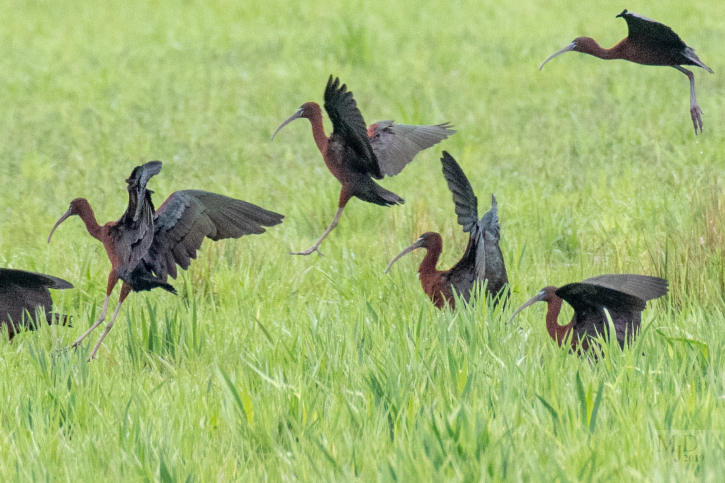
Another phenomenon we hope to see during migration, over the wet meadows at Scotland Road or other fields, is what I think of as a “swallow net.” If you are there at the right moment, scores or even hundreds of swallows, often of five species, form a layer of aerial insectivory, somewhere between 5 and 20 feet above the ground. They never stop moving, and woe to any flying insect in that space. We did indeed find a small swallow net on Wednesday. When you encounter that behavior on a large scale, what is most stunning is the silence of such a huge, active congregation.
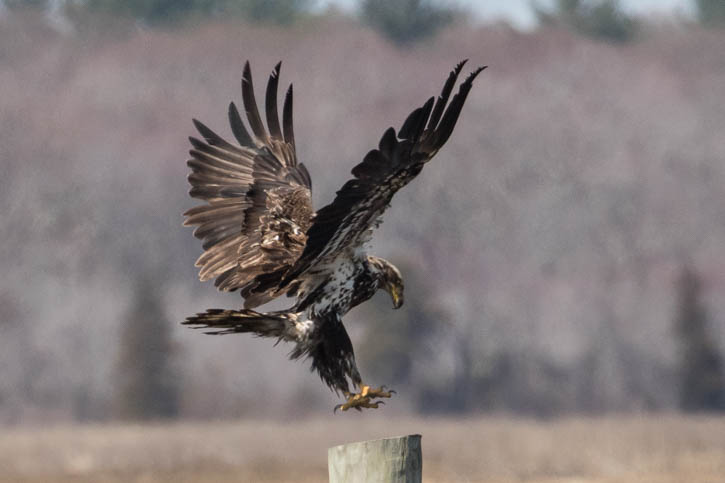
With the sun emerging, and reports of “tons of warblers!” we scurried over to Plum Island. We were a bit gobsmacked by the size of a 2nd-year Bald Eagle we discovered on a utility pole near the bridge. Next, parking lot #1 at Parker River National Wildlife Refuge was encouraging: Purple Martins are back!! Now, I know everyone has their favorite sensory spring tonic. Garlicky Ramps from the woods of Vermont? Fiddleheads from a Silver Maple swamp? Go ahead and restart your spring energy with those, but give me the sound of Purple Martins for seasonal inspiration. Here’s how: go to PRNWR, parking lot #1, close your eyes, and take a sound bath!
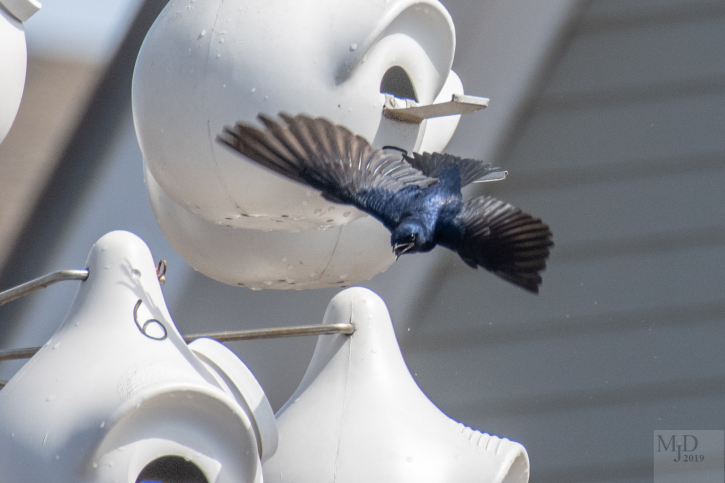
While we were also scoping out the two active Osprey nests in the North Marsh, some other fun birds showed up. A Tufted Titmouse (very uncommon on Plum Island!), Ruby and Golden-crowned Kinglets, and other passerines that came by predicted some real birdiness farther down the island. And raptors were on the move. Turkey Vultures soared, but perhaps were moving north a bit more? We caught sight of a Cooper’s Hawk moving slowly north and a handful of American Kestrels, one of which put on a show hovering over the highest dunes.
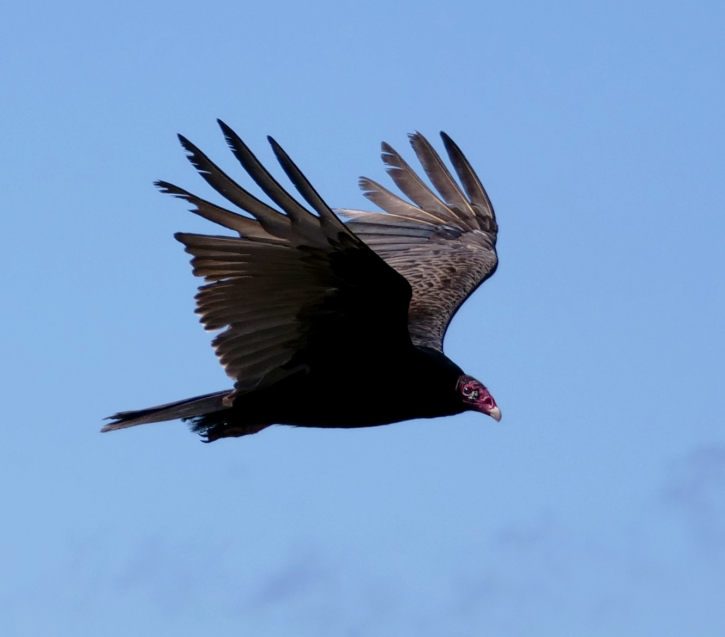
As we left the parking lot, a Brown Thrasher was singing in the middens. We listened to Eastern Towhees all along the refuge road. The salt pannes were not too ducky, but many more yellowlegs than we’ve seen so far were around. We made it to Hellcat after hearing one early Northern Parula in the S-curves. Disembarking at the Hellcat parking lot, we were greeted by a strong chorus of Yellow-rumped Warblers. There were lots of them all through the thickets and trees around the restrooms. We luxuriated in the sound and obvious display of “zugunruhe,” or migratory energy. Of the dozens of birds that we saw that morning, only two were females. All those gorgeous males, in their alternate plumage, chasing each other around and foraging so vigorously, meant the big spring migration began for us in these moments.
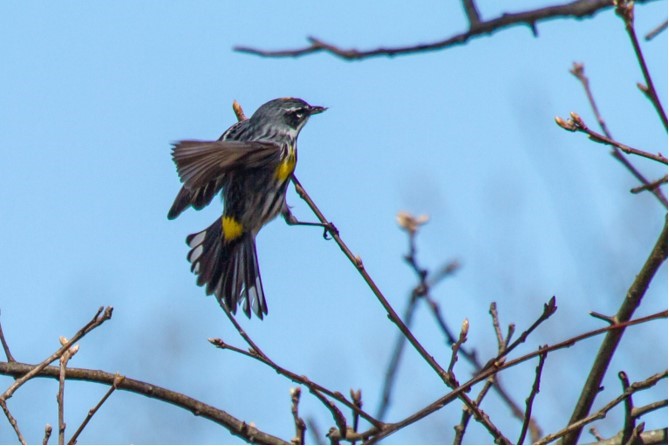
The many Yellow-rumped Warblers were joined by two Black-and-white Warblers, the first of which was a male that posed as if for a fashion shoot, and a similarly cooperative Blue-headed Vireo, another member of the community of early migrating species. We heard the song of Ruby-crowned Kinglets, which we had noted via a recording before we left, and lots of other singing birds, such as White-throated Sparrows, House Finches, one Purple Finch, and more.
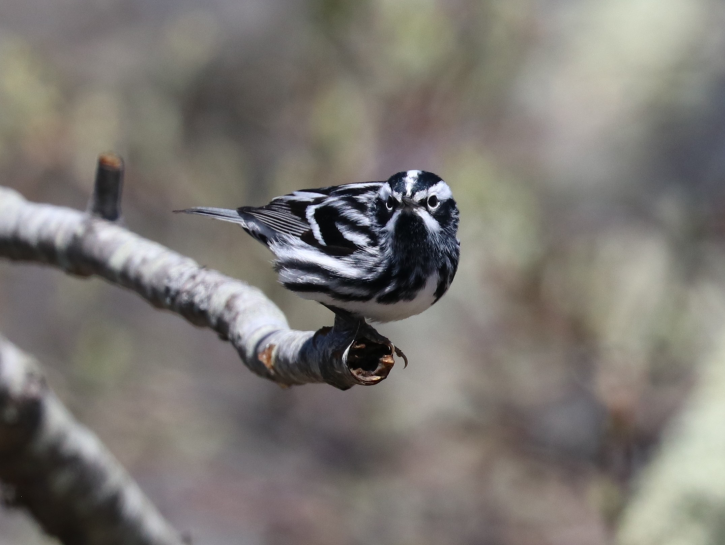
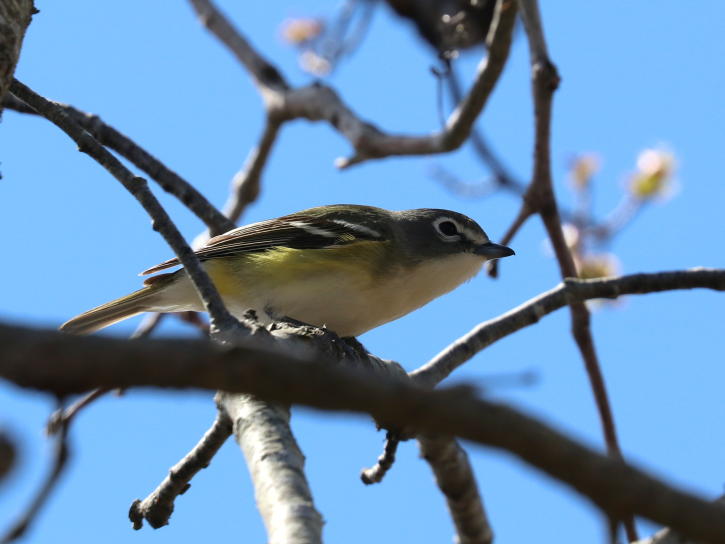
In a celebratory mood, we headed north for Joppa Flats. But, seeing a couple of very respected birders intently viewing something in a marshy spot in the S-curves, we carefully got out to see what it was. An early Northern Waterthrush skulked about, but it did come out enough for everyone to see. More of the same set of species we had seen at Hellcat showed up, and only the mention of fish tacos could dislodge the birders to head home. Thus begins our short, somewhat frenetic season of joyful discovery. We hope your experience of spring migration is off to a good start, and that we can appreciate it together at some point!
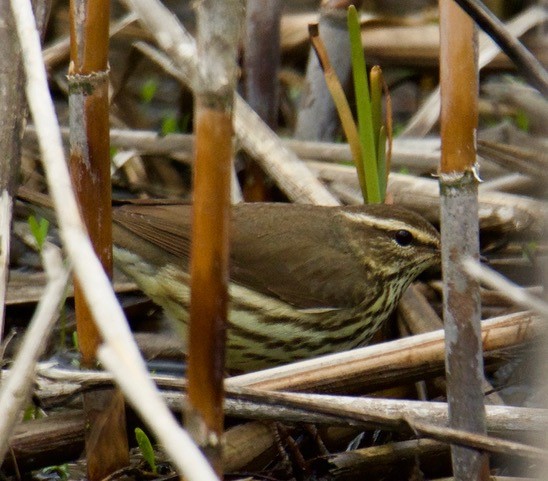

Our Lists –
Scotland Road, and along the way to Plum Island:
Canada Goose – common.
Mallard (1) – Common Pasture.
Long-tailed Duck (200+) – Merrimack River.
Wild Turkey (1) – en route.
Double-crested Cormorant – common (Merrimack River).
Glossy Ibis (12) – Common Pasture.
Turkey Vulture (2) – en route.
Rock Pigeon – common.
Eastern Phoebe (1) – en route.
Tree Swallow (50) – Common Pasture.
Rough-winged Swallow (2) – Common Pasture.
Cliff Swallow (1) – Common Pasture.
Barn Swallow (15) – Common Pasture.
American Robin – common.
European Starling – common.
Song Sparrow – common.
Red-winged Blackbird – common.
Common Grackle – common.
House Sparrow (7) – shrubs at Common Pasture.
Plum Island:
Canada Goose – common.
Gadwall (4) – Pannes.
American Black Duck – common.
Mallard – common.
Green-winged Teal (20) – Bill Forward Pool, south end.
Bufflehead – (2) Bill Forward Pool.
Red-breasted Merganser (5) – various, marsh side.
Wild Turkey (1) – S-curves.
Double-crested Cormorant – common.
Great Blue Heron (2) – North Marsh.
Great Egret – common.
Turkey Vulture (6) – various.
Bald Eagle (1) – immature, PI Bridge and North Marsh.
Northern Harrier (2) – Salt Pannes.
Cooper’s Hawk (1) – approaching parking lot #1.
Osprey (5) – 2, boat ramp platform; 1, North Marsh Platform; 1 North Marsh; 1, Pines Platform.
Red-tailed Hawk (2) – various.
Killdeer (4) – Salt Pannes.
Greater Yellowlegs – common.
Herring Gull – common.
Great Black-backed Gull (1) – North Marsh.
Rock Pigeon – common.
Mourning Dove – common.
Downy Woodpecker (1) – parking lot #1.
Northern Flicker (3) – roadside.
American Kestrel (4) various.
Blue-headed Vireo (2) – 1, Hellcat; 1, S-curves.
American Crow (2) – North Marsh.
Purple Martin (3) – parking lot #1.
Tree Swallow – common.
Northern Rough-winged Swallow (1) – Hellcat.
Black-capped Chickadee (4) – 2, parking lot #1; 2, S-curves.
Tufted Titmouse (1) – parking lot #1.
Red-breasted Nuthatch (1) – Goodno Crossing.
White-breasted Nuthatch (2) – Goodno Crossing.
Golden-crowned Kinglet (1) – parking lot #1.
Ruby-crowned Kinglet (3) – various.
American Robin- common.
Northern Mockingbird (5) – various.
Brown Thrasher (2) – singing near parking lot #1, and Hellcat.
European Starling – common.
Northern Waterthrush (1) – S-curves.
Black-and-white Warbler (3) – various.
Northern Parula (1) – S-curves.
Yellow-rumped Warbler – abundant.
Eastern Towhee – common .
Chipping Sparrow (3) – various.
Song Sparrow – common.
White-throated Sparrow (1) – Hellcat.
Dark-eyed Junco (1) – roadside.
Northern Cardinal (2) – Hellcat.
Red-winged Blackbird – common.
Common Grackle – common.
Brown-headed Cowbird (1) – Hellcat.
Purple Finch (1) – Hellcat.
House Finch – common.
American Goldfinch (1) – Hellcat.
House Sparrow – common.
Canada Goose – common.
Gadwall (4) – salt pannes.
American Black Duck – common.
Mallard – common.
Green-winged Teal (20) – Bill Forward Pool, south end.
Bufflehead (2) – Bill Forward Pool.
Red-breasted Merganser (5) – various, marsh side.
Wild Turkey (1) – S-curves.
Double-crested Cormorant – common.
Great Blue Heron (2) – North Marsh.
Great Egret – common.
Turkey Vulture (6) – various.
Bald Eagle (1) – immature, PI Bridge and North Marsh.
Northern Harrier (2) – salt pannes.
Cooper’s Hawk (1) – approaching parking lot #1.
Osprey (5) – 2, boat ramp platform; 1, North Marsh platform; 1 North Marsh; 1, Pines platform.
Red-tailed Hawk (2) – various.
Killdeer (4) – salt pannes.
Greater Yellowlegs – common.
Herring Gull – common.
Great Black-backed Gull (1) – North Marsh.
Rock Pigeon – common.
Mourning Dove – common.
Downy Woodpecker (1) – parking lot #1.
Northern Flicker (3) – roadside.
American Kestrel (4) – various.
Blue-headed Vireo (2) – 1, Hellcat; 1, S-curves.
American Crow (2) – North Marsh.
Purple Martin (3) – parking lot #1.
Tree Swallow – common.
Northern Rough-winged Swallow (1) – Hellcat.
Black-capped Chickadee (4) – 2, parking lot #1; 2, S-curves.
Tufted Titmouse (1) – parking lot #1.
Red-breasted Nuthatch (1) – Goodno Crossing.
White-breasted Nuthatch (2) – Goodno Crossing.
Golden-crowned Kinglet (1) – parking lot #1.
Ruby-crowned Kinglet (3) – various.
American Robin- common.
Northern Mockingbird (5) – various.
Brown Thrasher (2) – singing near parking lot #1, and Hellcat.
European Starling – common.
Northern Waterthrush (1) – S-curves.
Black-and-white Warbler (3) – various.
Northern Parula (1) – S-curves.
Yellow-rumped Warbler – abundant.
Eastern Towhee – common.
Chipping Sparrow (3) – various.
Song Sparrow – common.
White-throated Sparrow (1) – Hellcat.
Dark-eyed Junco (1) – roadside.
Northern Cardinal (2) – Hellcat.
Red-winged Blackbird – common.
Common Grackle – common.
Brown-headed Cowbird (1) – Hellcat.
Purple Finch (1) – Hellcat.
House Finch – common.
American Goldfinch (1) – Hellcat.
House Sparrow – common.

